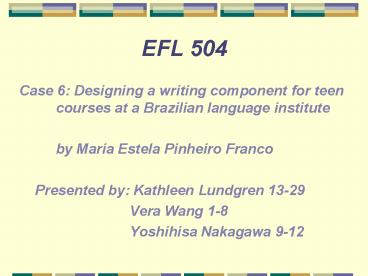EFL 504 - PowerPoint PPT Presentation
1 / 29
Title: EFL 504
1
EFL 504
- Case 6 Designing a writing component for teen
courses at a Brazilian language institute - by Maria Estela Pinheiro Franco
- Presented by Kathleen Lundgren 13-29
- Vera Wang 1-8
- Yoshihisa Nakagawa 9-12
2
Introduction
- Pinheiro is a teacher with more than twenty
years experience in EFL and elementary
education. - She is a branch supervisor in Sao Paula, Brazil.
- She is responsible for both teaching and course
development.
3
The course development focuses
- Selecting and developing materials and activities
- Organization of materials and content
4
Why does Pinheiro develop a writing supplement?
- Their students
- couldnt write well
- would be better prepared for the intermediate
course - would have a better knowledge and awareness of
the new language they were using - The written language is also used for
communication
5
Preteen course (ages 10-12)
6
Teen course (ages 13 to 16)
7
Considerations in designing the activities
- About the students
- Who are they
- What are they like
- How to motivate them
- Have a purpose
- Be enjoyable or challenging
- About the students likes and interests
- Should be linked to their reality and needs
8
Decide
- What students needed to learn
- What kind of input the teacher would give
- What activities the students would do for each
level
9
Goals Objectives
- Pinhero wants students to
- Be creative and critical
- Write
- Understand their mistakes
- Correct their own errors
10
In order to achieve the goals
- Process is emphasized, but not the product
- Interaction/Collaboration is importantly engaged
in the writing process
11
Because
- If the prework activities were done well, the
actual writing would be easier. (Process ?
Product) - Writing process is not liner but is cyclical.
(This helps students self-correct and think
critically. )
12
Theories
- Theories to support the focus.
- e.g) - Importance of interaction in writing
process - ?
- Vygotsky (1988) points out that there
is no development or learning without
interaction among people and that the human
being first experiences active problem-solving
activities in the presence of others.
13
Activities
14
WRITING FOLDER
- Introduction (Objective)
- Students will organize ideas clearly and
coherently so that they arrive at a correct and
interesting final product.
15
- 3-4 Activities
- Describing an Object
- Describing a Person
- Sequence in Writing
- Writing a Narrative
16
- Procedures
- Lead-in Activities
- Warm ups
- Familiarization
- First Draft
- Working on Idea
- Little Emphasis on Structure and Form
- Peer Feedback
17
- Second Draft
- Attention to Content, Structure and Form
- Teacher Feedback
- Objectivity
- Attention to Form and Structure but. . .
- Always Give Some Positive Feedback
- Circle Mistakes (so students can discover why
something is wrong - Cross Out Repetitive Words/Suggest Synonyms
- Use Check Lists and Lists of Error Correction
Symbols
18
- Third Draft
- Based on Corrections from Drafts 12
- Teachers Role Based on
- Attitude vs. Mistakes
- Did the Student Actively Participate?
- Did the Student Put Effort into the Activity?
- Did the Student Hand In All Assignments?
- Remember to Give Positive Feedback
19
Analysis
20
- Solid Rationale for Proposing Writing Supplement
- Writing was seen as a way to reinforce other
skills and help with a skill that could be used
outside the classroom
21
- Main Challenge
- Figuring Out How to Engage and Motivate Students.
. . - Who are They?
- What Engaged Them in Other Classes?
- What Interests Them
22
- Reflection and Assessment Process Lead to the
Development of Materials and Themes - Developing Materials was Synonymous with
Developing Activities (i.e. TimeLine)
23
- Activity Design
- A Set of Tasks Resulting in the Students
Writing Something
24
Attention to Theories
- Observing how students worked with each other
combined with theories about how writing is
learned and how learning takes place led to - Teaching Writing as a Process which led to Peer
Review Practice and Creative and Critical
Development - Utilizing Collaborative Activities Based on the
Role of Interaction in Learning
25
Sequencing Within and Across Levels
- Complexity of Content and Structure
- Amount of Writing
- Moving from Structured Tasks to Greater Student
Input, Imagination, and Creativity - Attention to How a Task Builds on Previous Tasks
26
Teacher Training Objectives
- To Ensure that Teachers had
- A Clear Understanding of the Theory Underlying
the Syllabus - A Clear Understanding of how Theory was
Manifested in the Activities - Motivation for Teachers to Want to Teach the
Supplement
27
- OPTIMAL SITUATION
- TIME and SUPPORT from INSTITUTION to DESIGN and
PILOT ACTIVITIES
28
- Pinheiros Criteria
- for Activity Design
- Topics are of interest to the students
- Each activity has a purpose
- Activities challenge students and teach them
something new - Success depends on students working together and
exchanging ideas
29
Considerations
- Which of the criteria are useful for you to
consider in sequencing the content and material
in your course? - Why?































